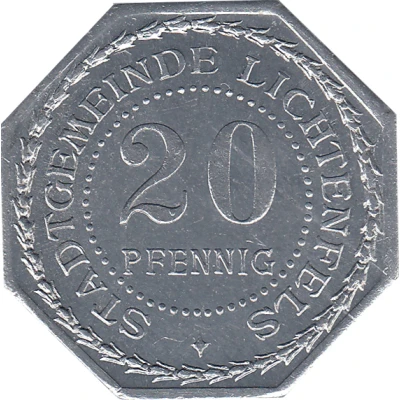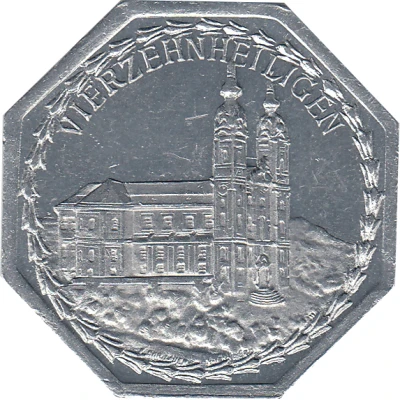


© ǝRBe
20 Pfennigs - Lichtenfels Schloss Banz ND
1921 year| Aluminium | 1.30 g | 24.00 mm |
| Issuer | City of Lichtenfels in Oberfranken (Federal state of Bavaria) |
|---|---|
| Period | Weimar Republic (1918-1933) |
| Type | Standard circulation coin |
| Year | 1921 |
| Value | 20 Pfennigs (20 Pfennige) (0.20) |
| Currency | Mark (1914-1924) |
| Composition | Aluminium |
| Weight | 1.30 g |
| Diameter | 24.00 mm |
| Thickness | 1.20 mm |
| Shape | Octagonal (8-sided) |
| Technique | Milled |
| Orientation | Medal alignment ↑↑ |
| Demonetized | Yes |
| Updated | 2024-10-04 |
| Numista | N#240791 |
|---|---|
| Rarity index | 93% |
Reverse
Wreath around rim, legend above Banz Castle
Script: Latin
Lettering: SCHLOSS BANZ
Edge
Plain
Interesting fact
The 20 Pfennigs - Lichtenfels (Schloss Banz) ND (1921) coin was issued during a time of economic turmoil in Germany, known as the "Inflationary Period" (1914-1923). During this time, the value of the German mark dropped significantly, and the government was forced to print more and more money to keep up with the increasing prices. This led to a period of hyperinflation, where the value of money dropped rapidly and the price of goods and services skyrocketed. The 20 Pfennigs coin, made of aluminum and weighing only 1.30 grams, was a response to the need for a stable currency during this time. It was designed to be a more durable and practical alternative to the paper money that was being printed in large quantities and quickly losing value.



